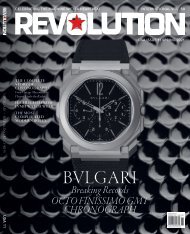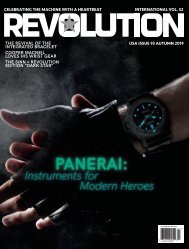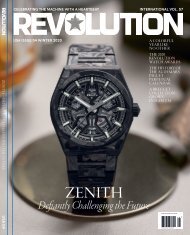You also want an ePaper? Increase the reach of your titles
YUMPU automatically turns print PDFs into web optimized ePapers that Google loves.
A NEW<br />
PULSE<br />
Hamilton revives a memorable icon 50 years later.<br />
The PSR flawlessly combines retro-futuristic style<br />
and modern technology.<br />
WORDS KEVIN CUREAU<br />
The 1970s were an era of great positive change for the US and<br />
around the world. Countries were still experiencing high<br />
and sustained growth from the post-World War II economic<br />
expansion, activism for women and minorities continued from the<br />
previous decade, environmental issues became more important, and<br />
rock and disco music dominated the charts.<br />
Entering the ’70s, it was clear that the United States had won the<br />
coveted “Space Race” with the success of the Apollo 11 mission which<br />
landed humans on the Moon in July of 1969. Only 10 months after that<br />
historical achievement, in May of 1970, another American company<br />
would make an announcement and reveal a ground-breaking product<br />
unlike anything that had been seen before: the Hamilton Pulsar, the<br />
very first digital wristwatch.<br />
Named after the pulsating neutron stars that emit beams<br />
of radiation at ultra-precise frequencies, this “solid state wrist<br />
computer” seemed like an object straight out of science fiction and<br />
perfectly in sync in terms of design with the Space Age period that<br />
the world was experiencing. The Pulsar was developed by Hamilton<br />
in its hometown of Lancaster, Pennsylvania, and would change<br />
the way we tell time. With no moving parts, no ticking sound and<br />
unmatchable durability and accuracy, this was something no one<br />
had ever seen before. At the push of a button, red LED numerals<br />
would light up the dark screen displaying the time. Holding the<br />
button for longer revealed the passing seconds. Setting the time<br />
was done using a magnet bar stored in a hatch inside the bracelet’s<br />
deployant clasp. Placing the magnet on two grooves found on the<br />
watch’s caseback allowed it to cycle through the hours and minutes.<br />
The public received its first glimpse of the Hamilton Pulsar prototype<br />
on one of the most popular US TV programs, The Tonight Show,<br />
when host Johnny Carson demonstrated its unique functionality.<br />
What followed was an undeniable Pulsar fever. It took two<br />
more years for Hamilton to release a consumer-ready version of<br />
the Pulsar, the Hamilton Pulsar P1 with an avant-garde cushion<br />
case and bracelet in 18ct yellow gold, but the product just flew off<br />
the shelves. Even with a price tag of US$2,100 at the time (the cost<br />
of a family car), the initial 400 watches prepared for the launch all











